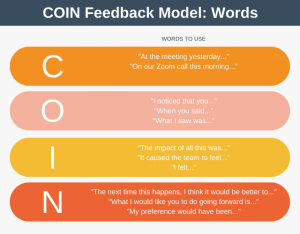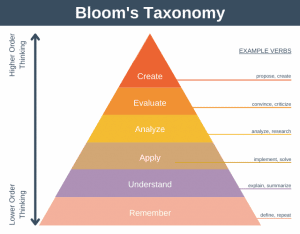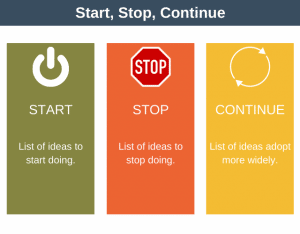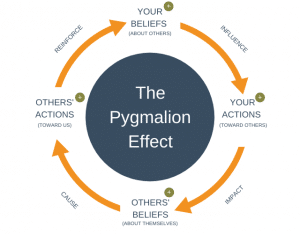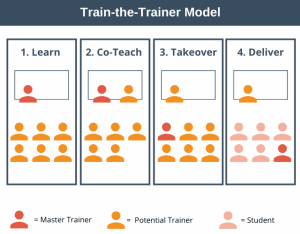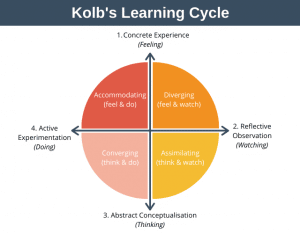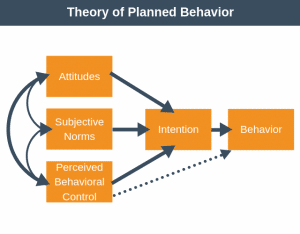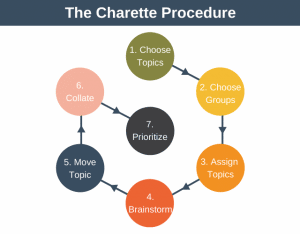Maslow’s Hierarchy of Needs, also known as Maslow’s Theory of Human Motivation, is a popular motivational theory explaining that as humans, our actions are motivated by our desire to meet specific needs.
Maslow focused in particular on the needs of employees in the workplace. His theory proposes that there are five types of needs that employees need to have fulfilled in the workplace for them to reach their full potential.
The five needs come in a particular order. When one of the needs is satisfied, the employee would be motivated by having the opportunity to meet the next set of needs in the hierarchy.
Background
Abraham Harold Maslow (1908 – 1970) was an American psychologist who is most well known for creating Maslow’s Hierarchy of Needs.
He first published this theory in a 1943 paper entitled, “A Theory of Human Motivation.”
In 1954, Maslow explained the theory in more detail in his book, “Motivation and Personality.” Other books written by Maslow include, “Toward a Psychology of Being”, and “Maslow on Management”.
Maslow was awarded the accolade of Humanist of the Year by the American Humanist Association in 1967.
Maslow’s Theory of Human Motivation
The earliest version of the theory, and still the most popular version today shows the five motivational needs drawn in a pyramid.
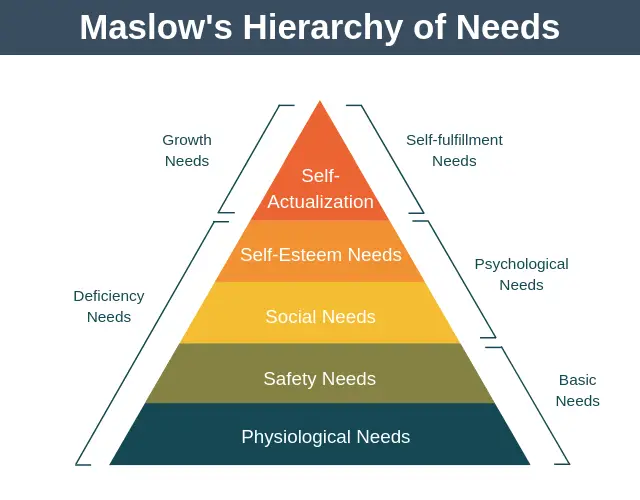
From the bottom to the top, Maslow’s five levels of needs are physiological needs, safety needs, social needs, esteem needs, and self-actualization needs.
The pyramid represents a hierarchy. What this means is that only when a lower-level need has been fully met would an employee then be motivated by the opportunity to meet the next level of their needs.
A classic example to explain this phenomenon is to consider a person who is dying of thirst in a desert. They will not be motivated by higher-level motivators, such as the opportunity to improve their French. Instead, they will only be motivated by their desire to quench their thirst, so they continue to live. This basic need must be met first.
The key to understanding Maslow’s Hierarchy of Needs is to realize that your needs are continually changing. What motivated you five years ago will not motivate you today.
Let’s examine each of Maslow’s 5 Levels of Needs in turn.
Deficiency Needs and Growth Needs
The model can be broken down into deficiency needs and growth needs.
Deficiency needs (D-needs) are those needs that motivate people when they are unmet. The first four levels in the hierarchy are deficiency needs.
Note that the longer deficiency needs go unmet, the stronger the desire to fulfill that need will become, therefore satisfying these needs is vital to avoid unpleasant feelings. So for example, the longer you go without water, the more crucial getting water will become to you.
The top-level of the hierarchy concerns growth needs. Confusingly, these are commonly known as B-needs, which simply means “being” needs.
Maslow’s 5 Levels of Needs
According to Maslow’s Theory of Human Motivation, you begin by being motivated to meet your lowest level of needs. Only once you have done this do you move on to being motivated to meet the next level of needs. This process continues until you reach the top level, self-actualization.
Although the theory was initially proposed as a rigid hierarchy, Maslow later modified it so that the progression up the hierarchy doesn’t have to be so strict and that levels can overlap to some extent. This makes sense because for some people achieving status (level 4) might be more important than attaining love (level 3).
Level 1: Physiological Needs
Physiological needs are the basic physical needs that you must meet for you to live. They are vital to your survival.
These needs include food to eat, water to drink, air to breathe, shelter to protect you from the elements, warmth to avoid freezing and sleep to refresh you.
Note that Maslow included sex within this category as a basic physical need because reproduction is vital to the survival of the human species.
Level 2: Safety Needs
Once you have met your physiological needs the next needs you will look to satisfy are your safety needs. Once our basic physical needs are satisfied, we all want to feel safe and secure.
These needs include being free from war, natural disasters, and violence.
In the workplace, these needs include job security, a safe working environment, having access to grievance procedures, saving some money each month, and knowing you have health insurance should you become ill.
Physiological needs and safety needs combined are often referred to as your basic needs.
Level 3: Social Needs
Once you meet your safety needs, the next needs you will look to satisfy are your social needs. At this level, you’ll have a desire to develop your interpersonal relationships. You want to feel as though you belong.
These needs include intimacy, friendship, and family.
According to Maslow, at this level, you will feel you need to belong to one or more groups. The group could be a family group, a workplace group, or a social group. Belonging to a group is commonly called affiliating, whereby you officially attach yourself to a club or group.
Feeling that people love you, that they care about you, and that you belong, can help you avoid issues such as loneliness, anxiety, and depression.
Level 4: Esteem Needs
Once you meet your needs at the lower three levels of Maslow’s Hierarchy of Needs, your esteem needs will become more important in influencing and driving your behavior.
Esteem needs are your ego needs and status needs. At this level, you will be motivated by getting recognition from others, achieving high status, achieving respect, and feeling important.
In a nutshell, you want to feel like you are making a contribution to the world and that others recognize this contribution.
According to Maslow, there are actually two sets of esteem needs, lower esteem, and higher esteem. Lower esteem is simply the need for respect from others, whereas higher esteem is self-respect.
Note that if you meet your lower-esteem needs, but your higher esteem needs are unmet, then it can be common to suffer from a condition knows as imposter syndrome.
Esteem needs and social needs together are often called our psychological needs.
The lower four levels combined make up your deficiency needs – needs, which if unmet, will motivate you to fill them. We can now move on to look at growth needs.
Level 5: Self-Actualization Needs
Self-actualization, or fulfillment needs, is the drive to become the best that you can be. It’s about achieving your full potential as a human being.
You can think of the first four levels of the hierarchy as being a set of levels you must master to enable you to reach the self-actualization level.
Because we are each unique, at this final level, each of us will pick something individual to us at which we want to excel. It could be a desire to be the best parent. It could be a desire to be the best athlete you can be. It could be a desire to create the most beautiful art. It is a unique desire that motivates us each day.
Maslow’s Hierarchy of Needs in the Workplace
All of the needs that Maslow described in his Theory of Human Motivation are ones that employees will want to have satisfied in the workplace. Maslow’s Hierarchy of Needs doesn’t just exist for our personal lives but in all aspects of our lives.
To motivate employees, the organization needs to think of ways of incentivizing employees so that they feel as though each need is being met. This will give the employee the motivation to progress up the hierarchy.
Here are some examples of actions employers can take to motivate employees using Maslow’s Hierarchy of Needs.
1. Physiological Needs in the Workplace
If your employees can’t meet their basic physiological needs, then they won’t be motivated to try and move to the next level.
As an employer, you should ensure that your employees have a comfortable work environment, including access to clean water and restrooms.
2. Safety Needs in the Workplace
Employee morale will be low if employees don’t feel safe. That could mean that they are working in an unsafe environment, or it could mean that they are in fear of losing their job.
As an employer, you should ensure your employees are working in a safe environment, and that you treat them fairly. Handle redundancies and layoffs sensitively and carefully.
3. Social Needs in the Workplace
Employees want to feel as though they belong.
As an employer, you should ensure you provide team building socializing opportunities to your employees. It would help if you also communicated regularly with your team to keep them “in-the-loop” as to what’s going on in the organization. Regular communication is especially important if you manage remote workers.
4. Esteem Needs in the Workplace
Employees want to feel that they are doing a good job and that they are receiving recognition for their efforts.
As an employer, there are many ways you can recognize employees to boost their esteem. Recognition can include career opportunities, special assignments, training, praise, perks and awards, and engaging employees in the decision-making process.
5. Self-Actualization Needs in the Workplace
When all the other needs have been met, employees will want to be the best they can be at their job.
As an employer, it is your responsibility to help employees become the best version of themselves. Work with each employee to put them in challenging situations where they feel empowered to deliver. However, be careful that they aren’t in too challenging a situation as this will be demotivating.
Advantages and Disadvantages
There are several advantages and disadvantages associated with Maslow’s Hierarchy of Needs.
Advantages
- The model is easy to understand and apply at a basic level.
- It expresses the human desire to achieve and have more and more over time.
- It’s a holistic approach to motivation. Maslow’s model helps us understand that an employee won’t be motivated to perform even if promised a great reward when they are tired, cold, and hungry.
Disadvantages
- There is no way to test Maslow’s concept of self-actualization empirically.
- It doesn’t take account of cultural differences. For example, the need to feel part of a team is higher in China that it is in the US.
- Each person will value each need in a greater or lesser way. Esteem needs can be essential to you, but your peer may place a higher value on safety needs. For example, Van Gogh self-actualized through art but lived in poverty for his whole lifetime. This calls into question the need to move up the hierarchy one step at a time.
- In reality, we typically don’t focus on meeting one need and then meeting the next need. Instead, we can seek to satisfy many needs at the same time.
Tips to Self-Actualize
If you’re interested in being the best that you can be and reaching the top of Maslow’s Hierarchy of Needs, then here are some tips to help you get there. Although you will achieve self-actualization in your own unique way, there are many everyday habits and traits that people at this level share.
- Try doing something new instead of always doing things in the same way.
- Form your own opinions and beliefs instead of simply believing the perceived wisdom.
- Be honest. Never manipulate people.
- Be prepared to go against the crowd.
- Take responsibility for your own success and life.
- Work hard.
- Identify limiting beliefs and feelings that are holding you back and work to overcome them.
Maslow’s Hierarchy of Needs, Upgraded
In 1970 Maslow upgraded his original five-level model on two occasions. First, to include cognitive and aesthetic needs, and later to include transcendence needs.
Maslow’s 7 Stage Hierarchy of Needs
Sometimes called Maslow’s 7 Basic Needs, Maslow updated his model to include more growth needs while keeping the deficiency needs the same.
You can see The 7 Level Hierarchy of Needs in the diagram below:
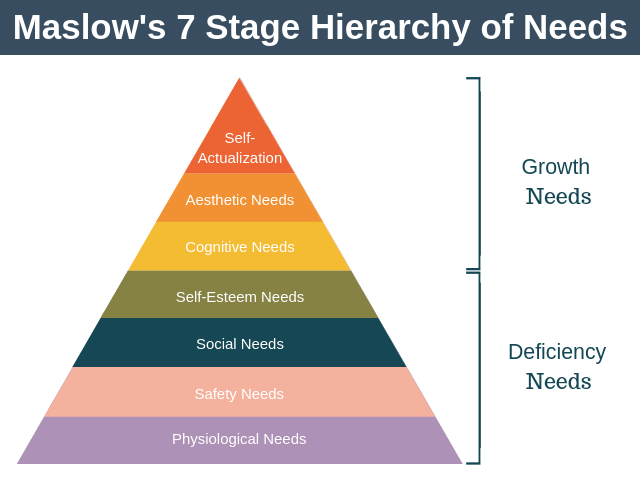
These two levels have the following meaning:
1. Cognitive needs
Once you have fulfilled your deficiency needs, Maslow believed that you would then be motivated by expanding your knowledge.
Cognitive needs reflect our need to discover, experiment, and learn how the world around us works to expand our understanding.
This is a crucial step towards self-actualization as it involves opening your mind up and exploring new ideas based on evidence.
2. Aesthetic Needs
The next step in moving towards self-actualization is fulfilling your aesthetic needs.
Once you have met your cognitive needs, you’ll seek to meet your aesthetic needs. This can mean appreciating beautiful things in your life, but it can also mean achieving balance. For example, walks in nature can lead to us feeling refreshed. Likewise experiencing music can also leave us feeling rejuvenated.
When we meet our aesthetic needs we feel intimately connected to the beauty of the world around us.
Maslow’s 8 Stage Hierarchy of Needs
Maslow’s 8 Stage Hierarchy of Needs again kept deficiency needs the same and added one final level to the seven basic needs.
This is shown in the diagram below:
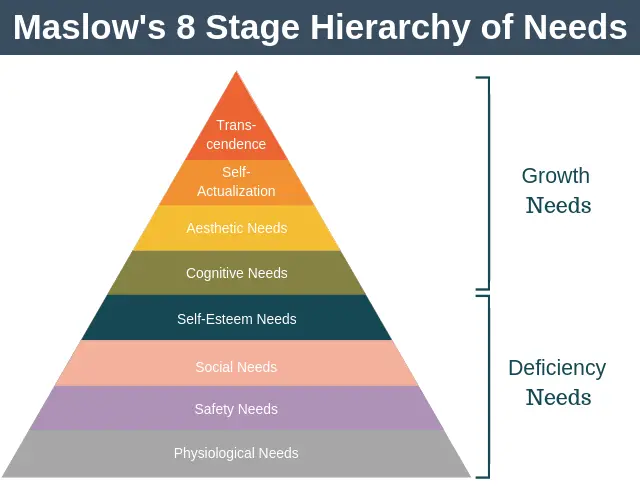
Transcendence is the very peak of the pyramid in the 8 Stage version of Maslow’s Hierarchy of Needs and refers to our spiritual needs.
We become motivated by values that transcend beyond our self.
Summary
Maslow’s Hierarchy of Needs shows how what motivates us is constantly changing. This means that what motivated an employee last year will probably not motivate them this year.
Maslow’s original hierarchy was broken into five levels. A person starts a the bottom of the hierarchy. Only once needs at the bottom of the hierarchy have been met will that person be motivated by trying to meet their needs at the next level.
Broadly speaking the model can be broken down into two categories of needs. First, deficiency needs, which motivate you if they are not present. Secondly, growth needs, which motivate you to grow and become the best you can be.
